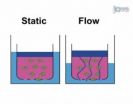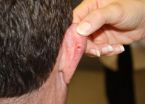(Press-News.org) July 25, 2012
There are many factors that affect tumor invasion, the process where a tumor grows beyond the tissue where it first developed. While factors like genetics, tissue type and environmental exposure affect tumor metastasis and invasion, physical forces like fluid flow remain a poorly understood component of tumor invasion. A new video article in JoVE, the Journal of Visualized Experiments, describes a novel procedure that allows researchers to study and test the microenvironment of a growing tumor. The technique is valuable because it allows scientists to assay tumor invasion attributable to extracellular fluid flow in vitro and better understand the effects of such physical changes on a tumor. The study focuses specifically on a type of extracellular fluid called interstitial fluid, which flows between cells in a tissue. This procedure is a significant first step to develop an in vitro system that better mimics what happens within a growing tumor in the patient.
"Our goal is to understand how physical forces affect how tumor cells behave. By understanding factors influencing why a tumor does or does not spread, we will have a much better understanding of which therapies will affect the tumor," said the article's author Dr. Adrian Shieh of Drexel University.
As tumors grow, they promote angiogenesis, or growth of new blood vessels, within the tumor itself and the surrounding tissue. Due to the leaky nature of these new blood vessels, there is an increase in the interstitial fluid pressure and flow. Dr. Shieh notes that current research approaches and therapies are not designed for targeting, addressing or understanding these physiological changes. The procedure published in JoVE demonstrates a better way to measure and understand the effects of interstitial fluid flow on tumor cells.
To mimic this physiological process, cells are embedded in a collagen matrix and pressure is applied to the liquid environment. This pressure causes the liquid to flow around the cell, mimicking in vivo conditions of a developing tumor. This allows scientists to study tumor growth and evaluate potential new therapies on cells in culture systems that more closely resemble physiological conditions.
Dr. Shieh hopes that publication of this article in JoVE's video format will bring more awareness to the study of interstitial fluid flow in tumor cells and that it will demonstrate an accessible system to study the phenomenon. He emphasizes, "For many new techniques, even when accompanied by a detailed text protocol, it is very difficult for someone to pick up the procedure and correctly perform the assay. Tremendous expertise and hours of practice are needed to successfully complete this procedure. This multimedia publication format helps demonstrate the finesse required to perform this technique."
INFORMATION:
Shieh et. al.: http://www.jove.com/video/4159/three-dimensional-cell-culture-model-for-measuring-effects
About JoVE, The Journal of Visualized Experiments:
JoVE, the Journal of Visualized Experiments, is the first and only PubMed/MEDLINE-indexed, peer-reviewed journal devoted to publishing scientific research in a video format. Using an international network of videographers, JoVE films and edits videos of researchers performing new experimental techniques at top universities, allowing students and scientists to learn them much more quickly. As of July 2012, JoVE has published video-protocols from an international community of nearly 6,000 authors in the fields of biology, medicine, chemistry, and physics.
URL: www.jove.com
To link to this release, please use this link: http://www.jove.com/about/press-releases/40/how-the-fluid-between-cells-affects-tumors
Contact:
Neal Moawed
Academic Liaison & Marketing Associate
The Journal of Visualized Experiments
p. 617.945.9051
e. neal.moawed@jove.com
How the fluid between cells affects tumors
2012-07-26
ELSE PRESS RELEASES FROM THIS DATE:
Piglets in mazes provide insights into human cognitive development
2012-07-26
URBANA -- Events that take place early in life almost certainly have consequences for later cognitive development. Establishing the connections is difficult, however, because human infants cannot be used as laboratory subjects.
Rodney Johnson and his collaborators have developed an alternative model for studying infant brain development. "Assistant professor Ryan Dilger and I became interested in establishing the neonatal piglet as a model of human brain and cognitive development 3 or 4 years ago," he said.
The idea came to Johnson when a former student, who was working ...
Texas A&M biologists prove ZOLOFT packs potential to fight fungal meningitis
2012-07-26
New research conducted by biologists at Texas A&M University suggests that ZOLOFT®, one of the most widely prescribed antidepressants in the world, also packs a potential preventative bonus — potent mechanisms capable of inhibiting deadly fungal infections.
The findings are the result of a two-year investigation by Xiaorong Lin, assistant professor of biology, and Matthew S. Sachs, professor of biology, involving sertraline hydrocholoride (ZOLOFT) and its effects on Cryptococcus neoformans, the major causative agent of fungal meningitis — specifically, cryptococcal meningitis, ...
Increasing dopamine in brain's frontal cortex decreases impulsive tendency, UCSF-Gallo study finds
2012-07-26
Raising levels of the neurotransmitter dopamine in the frontal cortex of the brain significantly decreased impulsivity in healthy adults, in a study conducted by researchers at the Ernest Gallo Clinic and Research Center at the University of California, San Francisco.
"Impulsivity is a risk factor for addiction to many substances, and it has been suggested that people with lower dopamine levels in the frontal cortex tend to be more impulsive," said lead author Andrew Kayser, PhD, an investigator at Gallo and an assistant professor of neurology at UCSF. "We wanted to ...
Tropical arks reach tipping point
2012-07-26
Almost half of the tropical forest reserves in a new study are ineffective, according to results published in the journal Nature by William Laurance, research associate at the Smithsonian Tropical Research Institute now at James Cook University in Australia and more than 200 co-authors.
"Biodiversity is declining rapidly at reserves including Kahuzi Biega in the Democratic Republic of Congo, Xishuangbanna in southern China, and Northern Sierra Madre in the Philippines, among others," said Laurance. "Reserves that are doing relatively well include Bwindi Impenetrable N.P. ...
Researchers find new gene mutation associated with congenital myopathy
2012-07-26
Ann Arbor, Mich. — University of Michigan researchers have discovered a new cause of congenital myopathy: a mutation in a previously uncharacterized gene, according to research published this month in the American Journal of Human Genetics.
About 50% of congenital myopathy cases currently do not have a known genetic basis, presenting a clear barrier to understanding disease and developing therapy, says James Dowling, M.D., Ph.D., the paper's co-senior author and assistant professor of Pediatric Neurology at the University of Michigan's C.S. Mott Children's Hospital. Finding ...
Basal cell carcinoma risk can be chronic
2012-07-26
PROVIDENCE, R.I. [Brown University] — In the powerful sunlight of July, newly published results from a large study of people at high risk for basal cell carcinoma support the emerging view of the nation's most common cancer as a chronic ailment that often repeatedly afflicts older people but for which the seeds may be planted in youth. The research also found a new association with eczema.
"Basal cell carcinoma is a chronic disease once people have had multiple instances of it, because they are always at risk of getting more," said Dr. Martin Weinstock, professor of dermatology ...
High blood sugar, obesity increase risk for surgical site infection
2012-07-26
Two recent studies in the July issues of the Journal of Bone and Joint Surgery (JBJS) looked at surgical site infections and hyperglycemia, the technical term for high blood glucose, or high blood sugar. According to the first study "Relationship of Hyperglycemia and Surgical-Site Infection in Orthopaedic Surgery," high blood sugar is a concern during the post-traumatic and post-operative period and it may help to preoperatively identify a population of patients with musculoskeletal injuries who are at significant risk for infectious complications.
Nearly, one-third ...
Sum of the parts? How our brains see men as people and women as body parts
2012-07-26
When casting our eyes upon an object, our brains either perceive it in its entirety or as a collection of its parts. Consider, for instance, photo mosaics consisting of hundreds of tiny pictures that when arranged a certain way form a larger overall image: In fact, it takes two separate mental functions to see the mosaic from both perspectives.
A new study suggests that these two distinct cognitive processes also are in play with our basic physical perceptions of men and women -- and, importantly, provides clues as to why women are often the targets of sexual objectification.
The ...
Alpine Fault study shows new evidence for regular magnitude 8 earthquakes
2012-07-26
RENO, Nev. – A new study published in the prestigious journal Science, co-authored by University of Nevada, Reno's Glenn Biasi and colleagues at GNS Science in New Zealand, finds that very large earthquakes have been occurring relatively regularly on the Alpine Fault along the southwest coastline of New Zealand for at least 8,000 years.
The Alpine Fault is the most hazardous fault on the South Island of New Zealand, and about 80 miles northwest of the South Island's main city of Christchurch.
The team developed evidence for 22 earthquakes at the Hokuri Creek site, ...
ACR: Medical imaging study in health affairs incomplete and potentially misleading
2012-07-26
In response to a study published in the August issue of Health Affairs regarding declining medical imaging use in recent years, the American College of Radiology (ACR) released a statement explaining that physician education efforts and quality assurance steps have resulted in more efficient use of imaging, but that arbitrary Medicare cuts are damaging patient access to care. The ACR also cited a December 2011 Health Affairs article that shows Medicare imaging cuts may have resulted in physical harm to patients.
"This Health Affairs study further supports the fact that ...




